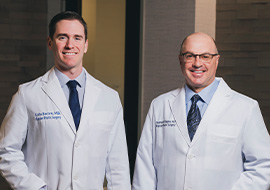
Ptosis Repair
Droopy Upper Eyelid Surgery
Correction of upper eyelid ptosis is usually surgical and is typically performed in adults as an outpatient under local anesthesia. The patient or surgeon often elects to have an anesthesiologist present to administer intravenous sedation and provide monitored care. It is important to do with minimal sedation because this allows the surgeon to better gauge how much to raise the eyelids.
If eyebrow elevation is to be performed, this is often carried out prior to eyelid ptosis repair and/or blepharoplasty surgery. Following the administration of a local anesthetic, an incision is made in the upper eyelid crease (if present) and the levator muscle is identified, tightened, and reattached to the tarsal plate (the firm supporting structure of the upper lid). Temporary sutures are initially placed. The patient is typically sat upright during the surgery to assess for eyelid symmetry and adequate correction of the droopy eyelid(s). Eyelid ptosis surgery is a more technically challenging operation than blepharoplasty surgery (removal of extra eyelid tissue) and should only be performed by surgeons specializing in eyelid surgery with considerable experience in the nuances of ptosis repair.
 Watch to learn more about Ptosis Surgery
Watch to learn more about Ptosis Surgery
After Surgery
More frequent ocular lubrication is generally required for ptosis patients than patients only undergoing blepharoplasty surgery. Patients unable to instill lubricating eye drops or ointment should not undergo ptosis surgery.
Patients generally experience blurred vision at distance for around 10-14 days following ptosis repair. Blurred vision at near may take 3-4 weeks or more to resolve. Visual changes may be the result of reduced blinking, poor eyelid closure, and the use of eye drops and ointments. Some patients (<5%) may have a change in their refractive error and require an update in their spectacle correction. It is generally recommended that patients defer changes in their eye glass prescription for 3-4 months following ptosis surgery. Each patient heals differently and the time it takes for patients vision to return to baseline varies considerably from patient to patient.
Most individuals will have swelling and some degree of bruising that will gradually improve over the first 1 to 3 weeks. Patient healing, however, is variable with some individuals healing much quicker than others. Near complete tissue healing usually occurs by 4 months. For upper eyelid blepharoplasty and ptosis surgery, 3 to 5 days off work is average while up to 10-12 days may be best for those patients having both upper and lower eyelid blepharoplasty surgery. Patients with occupations requiring minimal physical activity may return to work sooner than those that operate a motorized vehicle or perform heavy lifting or climbing. Makeup can be applied to help hide residual bruising after two weeks. Contact lens wear is typically avoided during the first 2-3 weeks after surgery or until adequate blinking and eyelid closure returns.
Up to 2-3% of ptosis patients may require an office touch-up procedure to adjust eyelid height at around one to two weeks after surgery. This involves opening the incision and removing and/or adding sutures to reposition the eyelid height. Once the healing process has settled (at around 3-4 months), eyelid asymmetry requiring a touch-up procedure may be considered in up to 3-5% of ptosis patients. Patients with substantial overcorrection of their ptosis repair may require earlier surgical intervention to improve eyelid position and closure.
Complications of Eyelid Surgery
Excessive pain, bleeding, and infection are very uncommon. Severe loss of vision following surgery has been reported but fortunately is extremely rare (approximately 1 in 2,000 cases). It may occur if deep orbital hemorrhage (bleeding) occurs postoperatively. This typically would occur within the first 24 hours following surgery, so it important for patients to have a responsible adult with them the afternoon, evening, and day following eyelid surgery. Inadequate lubrication of the eyes following surgery may also result in corneal scarring or infection causing vision loss.
Summary
Adult ptosis (droopy eyelids) is a common condition. While ptosis surgery is a frequently performed operation, it is still considered one of the more challenging eyelid procedures performed in an oculoplastic surgeon’s practice. The variability of eyelid position inherent in adjusting a muscle in a thin, dynamic structure (The Eyelid) can not be over emphasized. In experienced hands, surgical correction of droopy eyelids is highly successful and typically results in improved eyelid comfort and appearance as well as an expanded field of vision. An acceptable result requires substantial patient compliance and close follow-up.
View Before/After Photos

Klapper Eyelid & Facial Plastic Surgery treats disorders, injuries, and other abnormalities of the eyelids, eyebrow, tear duct system, eye socket, and adjacent areas of the mid and upper face.
